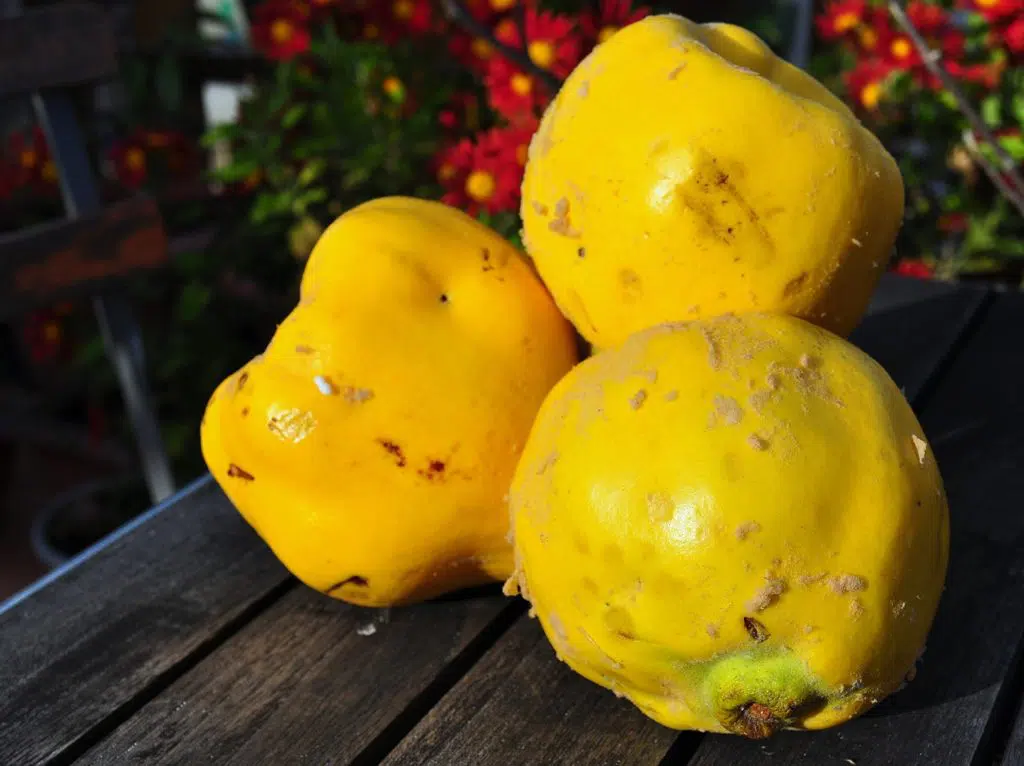
Ancient Greeks called quince “the golden apple.” This fruit, which has high nutritional value and medicinal qualities, also symbolized love in ancient times. Making a quince pie as an alternative to apple pie for Thanksgiving can be a delicious and unique twist.
The quince season lasts from October to December. It is then when the yellow fruit that looks like a cross between an apple and a pear is at its ripest and ideal for use in sweet recipes.
When eaten raw, it is dry and actually tastes sour or bitter. Generally, it is cooked, and if cooked with the right ingredients, it can work wonders in delicious sweets and an array of other dishes.
More importantly, this “golden apple” has important medicinal qualities and high nutritional value, making it an important part of one’s diet.
The quince bush grows wild in the Mediterranean countries, and its season is considered to be the end of autumn.
The Quince in mythology and tradition
The quince, which originated in the Caucasus, eventually made its way to ancient Greece, where the fruit first appeared in Cydonia (Κυδωνία) in northern Crete, in today’s Chania, where it got its name.
It is common belief that the quince even predates the apple, and some believe many references to “apples” in antiquity actually meant the quince — including the story of the apple Eve gave to Adam.
Ancient Greeks called them “melimilon;” according to Greek mythology, the quince is associated with Aphrodite, the Greek goddess of beauty and love.
In ancient art, Aphrodite is often depicted holding a quince, the fruit that symbolizes not only love, but beauty and fertility as well.
Ancient Greeks, who closely associated it with fertility, gave it a prominent place in weddings, where it was offered as a gift; the bride also used them to freshen her breath before the ceremony.
In parts of northern Greece in the distant past, the family of the groom would accompany him to the church carrying a post with quince, pomegranates and apples tied to it.
Also, the bride was supposed chew on a quince at the ceremony to ensure the couple would have a baby boy.
Greek tradition also holds that if you see a quince in your dreams, you will have happiness and peace in your home.
Nutritional value
So many repeated references to quince in antiquity are not accidental, since the fruit contains important vitamins and nutrients that make it one of the healthiest of all fruits.
It has a high content of water, as well as potassium, while it also contains vitamins A, B complex, and C. It also contains a great amount of fiber, while among its nutrients are phosphorus and iron.
Quince is also rich in tannins which have a strong antioxidant effect, while it provides 60 calories per 100 grams.
A “Golden apple” a day keeps the doctor away
The benefits of quince are many, so it is healthy to add it to one’s diet as often as possible.
It has high pectin (soluble fiber) content, which helps control blood cholesterol levels and prevents constipation, helping those who are trying to lose weight.
Pectin is also important for those with Type 2 diabetes, since it slows down the absorption of sugar, stabilizing its levels in the blood.
The high content of vitamin C (a medium piece of fruit provides about 1/3 of the recommended daily allowance of the vitamin) stimulates the immune system as well.
However, the high dose of vitamin C comes only when we consume the quince raw. After it is cooked, a large part of the vitamin is lost.
Their high content of potassium is good for the heart as well, and according to research, a diet rich in potassium protects us from heart disease, while reducing the risks of high blood pressure and high cholesterol.
Quinces contain antioxidants which are good in one’s diet as they fight against agents that damage cells and make one prone to serious diseases such as cancer. At the same time, the antioxidants in quince show anti-aging properties too.
Wine made from quince is also considered very beneficial for those suffering from asthma.
Raw quince can also be used against diarrhea and according to studies it also has antiviral properties, which result mainly from substances found in the skin of the fruit.
Other important properties of quince include soothing an irritated stomach and improving digestive function; its juice, together with the pulp of a roasted or boiled quince, can be used as an antiemetic treatment.
Quince contains cuprum, which has multiple beneficial effects on the body, as it reduces tissue damage, supports bone and nerve health, and supports the function of the thyroid gland, reducing fatigue and weakness.
Finally, their proponents believe that frequent consumption of quinces facilitates the good function of our kidneys and liver.
See all the latest news from Greece and the world at Greekreporter.com. Contact our newsroom to report an update or send your story, photos and videos. Follow GR on Google News and subscribe here to our daily email!



